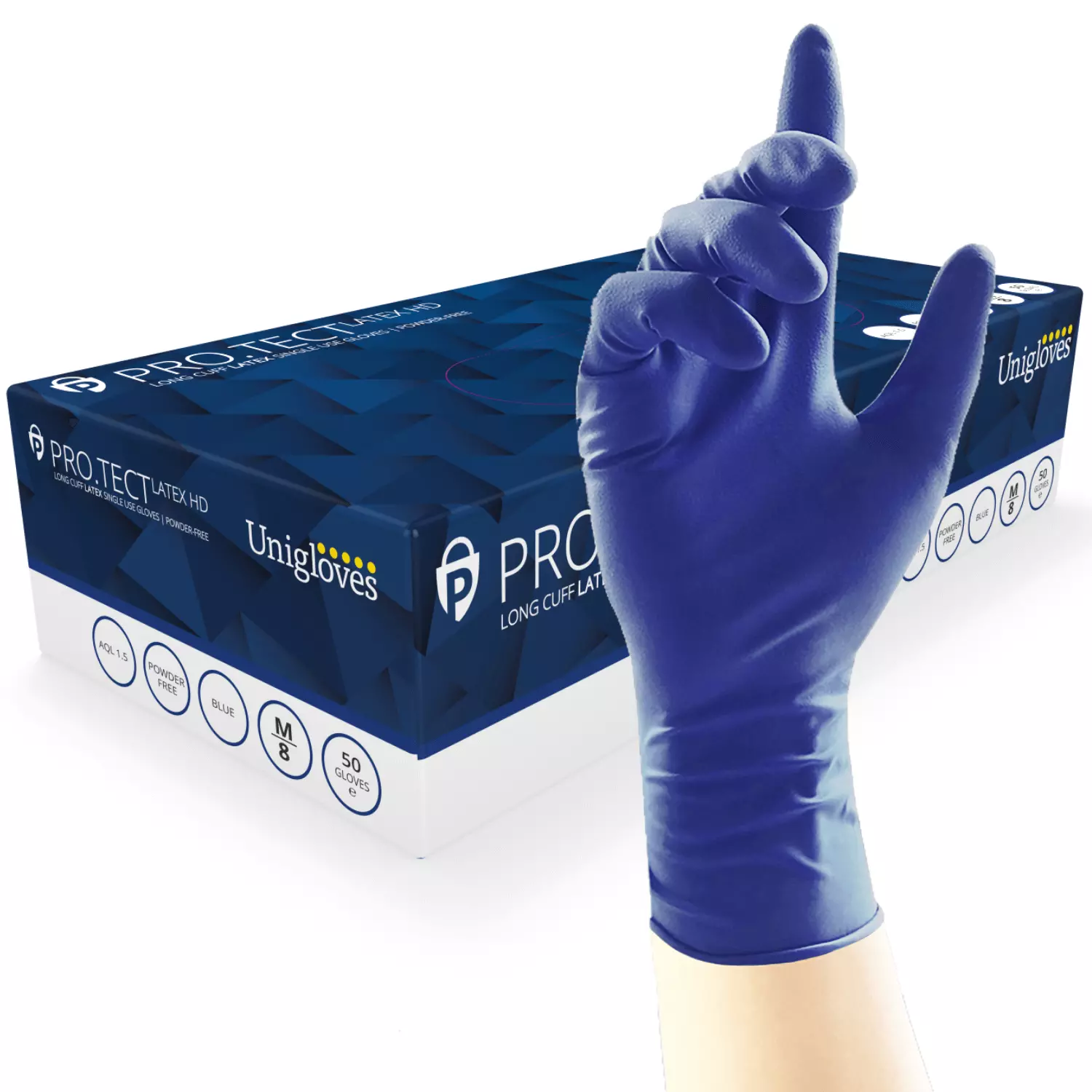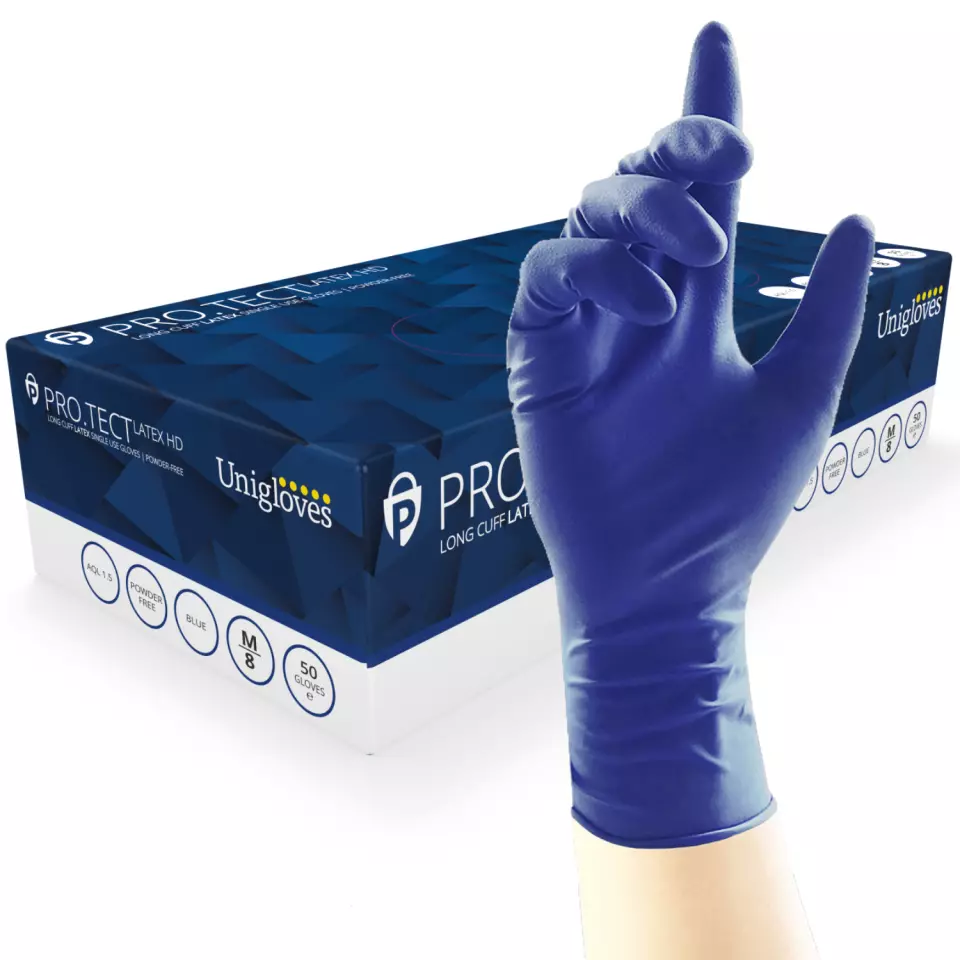
Unigloves PRO.TECT Heavy duty extended cuff blue latex gloves
Unigloves PRO.TECT Heavy duty extended cuff blue latex gloves
4.8 / 5


Features You'll Love

Fingertips · Textured
Surface · Textured
Describes the surface texture of the fingertip area, affecting grip strength and tactile sensitivity during use.
The texture of the glove exterior, affecting grip strength and handling capability for different tasks and working conditions.
Describes the surface texture of the fingertip area, affecting grip strength and tactile sensitivity during use.
The texture of the glove exterior, affecting grip strength and handling capability for different tasks and working conditions.
Describes the surface texture of the fingertip area, affecting grip strength and tactile sensitivity during use.
The texture of the glove exterior, affecting grip strength and handling capability for different tasks and working conditions.
Unigloves
PRO.TECT Heavy duty extended cuff blue latex gloves, 10 x 50 pcs
PRO.TECT Heavy duty extended cuff blue latex gloves, 10 x 50 pcs
4.8 / 5
84,22 €
Price per 10 packages (500 pcs)
16,84 € / 100 pcs
Shipping fee is 7,95 € for orders under 600,00 €
Features You'll Love

Fingertips · Textured
Surface · Textured
Describes the surface texture of the fingertip area, affecting grip strength and tactile sensitivity during use.
The texture of the glove exterior, affecting grip strength and handling capability for different tasks and working conditions.
Describes the surface texture of the fingertip area, affecting grip strength and tactile sensitivity during use.
The texture of the glove exterior, affecting grip strength and handling capability for different tasks and working conditions.
Describes the surface texture of the fingertip area, affecting grip strength and tactile sensitivity during use.
The texture of the glove exterior, affecting grip strength and handling capability for different tasks and working conditions.
Product description
• Tested to EN374
• Extended cuff (300mm glove length)
• AQL 1.5 and EN455 parts 1-4
• Free from powder
• Free from phthalates
• Tested to EN1186
• Ambidextrous
• Manufactured using high-quality latex
• Beaded cuff
• Manufactured with textured palms and fingertips
• Ultra-heavy weight construction
• Touchscreen compatible
• Tested to EN374
• Extended cuff (300mm glove length)
• AQL 1.5 and EN455 parts 1-4
• Free from powder
• Free from phthalates
• Tested to EN1186
• Ambidextrous
• Manufactured using high-quality latex
• Beaded cuff
• Manufactured with textured palms and fingertips
• Ultra-heavy weight construction
• Touchscreen compatible
• Tested to EN374
• Extended cuff (300mm glove length)
• AQL 1.5 and EN455 parts 1-4
• Free from powder
• Free from phthalates
• Tested to EN1186
• Ambidextrous
• Manufactured using high-quality latex
• Beaded cuff
• Manufactured with textured palms and fingertips
• Ultra-heavy weight construction
• Touchscreen compatible
Total mass of the glove package, useful for shipping calculations, storage planning, and comparing product quantities across different brands.
Indicates how long gloves maintain their protective properties and quality when stored properly, typically measured in years from manufacture date.
Indicates whether gloves contain powder on the interior surface to aid donning, affecting ease of use and contamination control requirements.
Indicates the maximum percentage of defective gloves acceptable in quality testing, with lower numbers representing higher quality standards.
Measures how far the glove extends up the wrist and forearm, determining the level of coverage and protection provided during use.
Measures the material thickness at the fingertips, affecting tactile sensitivity, dexterity, and protection level during use.
Measures the thickness of the glove's wrist/forearm extension, affecting durability, tear resistance, and protection level during use.
Describes the surface texture of the fingertip area, affecting grip strength and tactile sensitivity during use.
The base substance used to manufacture the glove, affecting chemical resistance, durability, flexibility, and compatibility with specific applications.
Complete finger coverage ensures full protection and hygiene for your hands, maintaining dexterity for all tasks.
Your go-to gloves for diverse tasks, offering reliable protection and convenience across many applications.
Easily wear on either hand, ensuring quick protection and less waste.
Effortlessly use touch screens without removing your gloves, ensuring continuous protection and hygiene.
Phthalate-free for reduced chemical exposure, offering a safer choice for you and the items you handle.
Chlorinated for easy donning and doffing, providing a smooth, powder-free experience for your hands.
Long sleeves offer extended protection, keeping your arms clean and dry from splashes and contaminants, even during immersion.
The visual appearance of the glove material, ranging from basic colors to specialized options for different professional and aesthetic preferences.
The texture of the glove exterior, affecting grip strength and handling capability for different tasks and working conditions.
Measures the material thickness at the palm area, affecting protection level and tactile sensitivity during use.
- Chemical Resistance
- Clean Room
- Food Service
- Water Resistance
- Medical Protection
- Hand Protection
Protective gloves with the EN 374-4:2013 rating are tested for their resistance to degradation by chemicals. This measures changes in the glove material, like swelling or hardening, ensuring the glove maintains its protective qualities when exposed to hazardous substances.
Test results
This glove's material resists breaking down when in contact with specific chemicals. This helps protect you from physical changes to the glove like swelling, cracking, or softening that could compromise your safety during use.
Single-use medical gloves with the EN 455-2:2015 rating are tested for physical properties like dimensions and strength. This ensures gloves fit correctly and are strong enough to provide reliable protection without tearing during use.
Test results
This product is tested for physical strength and durability to ensure reliable performance. It meets specific requirements for size, stretch, and force-at-break, providing adequate protection against cross-contamination for both the user and patient.
Medical gloves with the EN 455-1:2020 rating are tested for freedom from holes using a water tightness test. This ensures the gloves provide a reliable barrier, protecting you from cross-contamination and the spread of infections.
Test results
This rating indicates the glove's quality and resistance to pinholes, which is tested by filling it with water. A lower AQL number means a lower chance of defects, providing a more reliable barrier against microorganisms.
Single-use medical gloves with the EN 455-4:2009 rating are tested for their shelf life, ensuring they maintain properties like strength and barrier integrity over time. This means the gloves will remain effective and safe, providing reliable protection against infections until their expiration date when stored correctly.
Products from companies with the EN ISO 9001:2015 rating are tested for the company's systems for consistently providing quality products and services and meeting customer needs. This means the company is committed to consistent quality, aiming to meet your needs and improve its offerings, leading to more reliable products and better customer experience.
Test results
This certification shows a commitment to quality and consistency. It ensures the company's processes are managed to deliver reliable, effective service and a better customer experience from start to finish.
Protective gloves with the EN 420:2003+A1:2009 rating are tested for general design, safe materials (innocuousness), water penetration, comfort, and dexterity. This ensures the gloves are safe, fit correctly, and allow you to perform tasks effectively without discomfort.
Gloves with the EN ISO 374-1:2016 rating are tested for resistance against dangerous chemicals and microorganisms, including penetration, permeation, and degradation. This means you can choose gloves designed to protect your hands from specific chemical hazards, ensuring safer use in various tasks.
Test results
Provides splash protection against at least one specific chemical for more than 10 minutes. These gloves are suitable for tasks involving limited or short-duration contact with specified low-risk chemicals.
Gloves with the EN 374-5:2016 rating are tested for resistance to penetration by bacteria and fungi, and potentially viruses. This means the gloves provide a protective barrier against microorganisms, helping to keep your hands safe from harmful biological agents.
Test results
This product protects you from bacteria and fungi. It passed leakage tests, making it a reliable barrier when handling materials where these micro-organisms are a risk, such as in cleaning or laboratory work.
This glove is tested to protect you from bacteria, fungi, and viruses. It provides a reliable barrier, having passed specific tests to ensure no leakage when exposed to these micro-organisms, making it suitable for handling contaminated materials.
Gloves with the EN 374-2:2014 rating are tested for their resistance to penetration, ensuring liquids and microorganisms do not leak through tiny holes or imperfections. This means the gloves provide an effective barrier, protecting your hands from direct contact with hazardous chemicals and microbes.
Test results
This product has passed a leak test to ensure it is a waterproof and effective barrier against liquids, bacteria, and fungi. This protects your hands from contact with harmful microorganisms in various work environments.
Medical gloves with the EN 455-3:2015 rating are tested for biological safety, including protein, endotoxin, chemical, and powder content. This ensures the gloves are safe for use, reducing risks of allergic reactions and irritation for consumers.
Food safe refers to the safety of food products that are used or consumed by people. In Europe, food safety is regulated by the European Union (EU) and the European Food Safety Authority (EFSA). These organizations set standards and requirements for food products to ensure they are safe to eat. To be considered "food safe" in Europe, a product must meet these standards and be free of harmful substances. This includes being free of harmful bacteria, pesticides, and other contaminants. Food products that do not meet these standards cannot be sold or used in the EU.
Free delivery when you order more than 600,00 € from Unigloves
Supplier shipping fee 7,95 €
Brand minimum 0,00 €